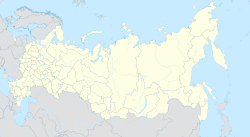Kineshma
Town in Ivanovo Oblast, Russia From Wikipedia, the free encyclopedia
Kineshma (Russian: Кинешма), the second-largest town in Ivanovo Oblast in Russia, sprawls for 15 kilometers (9.3 mi) along the Volga River, 335 kilometers north-east of Moscow. Population: 77,694 (2021 Census);[7] 88,164 (2010 Census);[2] 95,233 (2002 Census);[8] 105,037 (1989 Soviet census).[9]
Kineshma
Кинешма | |
|---|---|
 View of Kineshma from the Volga | |
| Coordinates: 57°26′N 42°08′E | |
| Country | Russia |
| Federal subject | Ivanovo Oblast[1] |
| First mentioned | 1429 |
| Area | |
• Total | 49 km2 (19 sq mi) |
| Elevation | 110 m (360 ft) |
| Population | |
• Total | 88,164 |
| • Rank | 191st in 2010 |
| • Density | 1,800/km2 (4,700/sq mi) |
| • Subordinated to | Town of Kineshma[3] |
| • Capital of | Kineshemsky District,[1] Town of Kineshma |
| • Urban okrug | Kineshma Urban Okrug[4] |
| • Capital of | Kineshma Urban Okrug,[4] Kineshemsky Municipal District[4] |
| Time zone | UTC+3 (MSK [5]) |
| Postal code(s)[6] | 155800 - 155819 |
| Dialing code(s) | +7 49331 |
| OKTMO ID | 24705000001 |
| Website | www |
Etymology
From a substrate Finno-Ugric language (cf. Meadow Mari: кыне ('kine', < Proto-Finno-Permic *känз), "hemp").[10]
History
Kineshma was first noticed as a posad in 1429.[11] In 1504, Ivan III gave it to Prince Feodor Belsky, who escaped to Moscow from Lithuania and married Ivan's niece. Later on, Ivan the Terrible gave Kineshma to Ivan Petrovich Shuisky, but after the latter's death it was returned to the Tsar in 1587. In the 16th and 17th centuries, Kineshma was a major fishing center, which supplied sturgeon for the Tsar's table. In 1608, it was twice ravaged by the Poles. Throughout its history, Kineshma belonged to different Russian regions, including Archangelgorod Governorate, Yaroslavl Province of Saint Petersburg Governorate, and Moscow Governorate.
Administrative and municipal status
Within the framework of administrative divisions, Kineshma serves as the administrative center of Kineshemsky District,[1] even though it is not a part of it.[3] As an administrative division, it is incorporated separately as the Town of Kineshma—an administrative unit with the status equal to that of the districts.[3] As a municipal division, the Town of Kineshma is incorporated as Kineshma Urban Okrug.[4]
Economy
Since the 18th century, the town's main industry has been textile manufacturing. Like all the textile centers in Russia, the town's prosperity declined after the perestroika. [citation needed]
Architecture
Kineshma's principal landmark is the Trinity Cathedral, built in 1838–1845 to a typical Neoclassical design. There are also several 18th-century churches in the town. The neighborhoods of Kineshma contain estates and museums of Alexander Ostrovsky, Alexander Borodin, and Fyodor Bredikhin.
In 2010, Kineshma was granted status of a town of historical significance.
Religion

Currently there are eleven churches, nine of which are active, and three chapels.
Notable people
- Alexander Borodin, composer and chemist
- Fyodor Bredikhin, astronomer
- Sergey Klyugin, Olympic high jumper
- Alexander Ostrovsky, writer
- Andrei Semenov, mixed martial artist
- Kostromin, musical artist
Twin towns – sister cities
 Vantaa, Finland
Vantaa, Finland Baranavichy, Belarus
Baranavichy, Belarus Gudauta, Abkhazia (De facto; de jure part of Georgia)
Gudauta, Abkhazia (De facto; de jure part of Georgia)
See also
References
External links
Wikiwand - on
Seamless Wikipedia browsing. On steroids.





